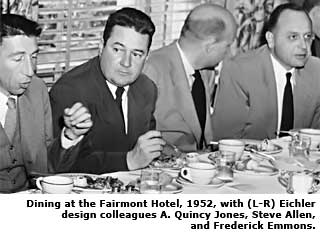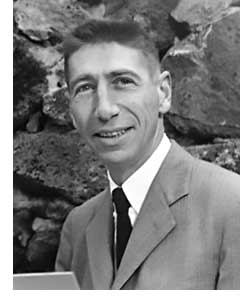Eichler Architect, Bob Anshen: Self-Made Man - Page 5
Despite his reputation for chasing women, however, Anshen found it hard at times to get his mind off work. Dancer (later, writer) Maya Angelou, who had a boat nearby, recalls a tête-à-tête with Anshen at one party. "Bob Anshen waved me over, and I stayed a while listening to him discourse on the merits of solar heating systems."

Anshen wasn't the world's most attentive dad. He'd buy Giants baseball tickets, but on game day a guy from the office would take John. Still, John admired his father greatly. "The way people showed him respect, a young boy feels that," he says. "It was because people genuinely liked him, and put up with his eccentricities."
John says his father, who was born in a suburb of Boston, never talked much about his past. He believes his father worked briefly on Wall Street before switching to architecture.
After Bob and Frances divorced in 1961, Anshen stayed involved with his children, sending John to boarding school in Arizona near the Chapel of the Holy Cross.
Anshen moved to then-largely undeveloped De Silva Island, actually a peninsula on Richardson Bay north of Sausalito, where he expanded an existing cottage, giving it a sunken living room that jutted out over the bay.
By 1962 Anshen was sharing the home and his life with a 30-ish artist, Sara Raffetto. It was a grand romance. "They were invited to dinner together, and they left before the salad was served," in the words of Raffetto's later companion, James Pratt, who called Anshen "her great love."
Anshen remained as upbeat, gregarious, and imaginative as ever, though when Donald Olsen ran into his old friend, he thought he looked ill and dissipated.
Anshen always pushed himself hard, his son says. "He would go to sleep late but get up early and go to work. He loved to go to work." He also used barbiturates to fall asleep, and on occasion had to use oxygen. "He never took care of himself. And he smoked like a maniac," John says.
Ever the marketer, Anshen concocted a new idea—he bought a gondola and sent it to a boatyard to be outfitted with a powerful engine. "He wanted to pick up clients at Fisherman's Wharf in his gondola to bring them over to De Silva Island and entertain them," Rath says.
Anshen and Raffetto had dinner at the Allen's home in the Sausalito hills on Sunday, May 24, 1964. Allen drove them home, apparently because Anshen lost his car keys. At 10:30 that night, Raffetto stumbled into a neighbor's house to report a fire. Neighbors saw Anshen in front of the house, but when firefighters arrived, he was gone. Raffetto, described by the sheriff as "an attractive blonde" and by the San Rafael Independent-Journal as a "mystery woman," was incoherent. The fire, which started under the house near an unused floor furnace, caused $1,000 in damage.
Later that evening, Allen noticed that Anshen's car was gone.

At nine the next morning, Anshen missed an important meeting with their Bank of California clients. Allen, who said his partner had been "in good health and spirits" the night before, called the police to report him missing. It's not clear if Allen knew about the fire. Around noon, Allen visited the apartment in their office on Bush Street in downtown San Francisco where Anshen sometimes stayed after a late night on the town. He found Anshen garbed in sweatshirt and shorts, dead at age 54.
'Mysterious Death of S.F. Architect' was the Chronicle's lead headline the next day. 'Twin Mysteries Probed in Death' was the Independent-Journal's. Anshen, the San Francisco coroner revealed, had been under treatment for low blood pressure, "a slight drinking problem, and depression."
The San Francisco coroner ruled the death accidental due to "barbiturate and alcohol poisoning." Arson investigators found a leaking oil line under the house and electrical problems.
Fourteen months after his death, the Independent-Journal announced a public auction. "In the market for a gondola? Here's a chance."
At Anshen and Allen offices, architects were distraught and shocked. They knew Anshen lived hard, but no one expected him to die. In retrospect, remembering how high spirited Anshen seemed, and how volatile, some said, yes, he might have been depressed. But no one ever saw him depressed.
No one took Anshen's death harder than Steve Allen. "Steve was never the same again," says Derek Parker, who became a partner in the firm shortly thereafter and helped it become the major firm it is today. "His energy level dropped, and he was less interested in the practice."
Asked about Anshen's virtues as an architect, Parker responds immediately. "Creativity, ideas. Nothing was sacred. He'd start each project anew. He had a good sense of design, a good sense of proportion. And he was always pushing for something new—not to be novel, but to solve the problem."
Photos: Ernie Braun, Maynard L. Parker (courtesy Huntington Library, San Marino, CA), Kelly Cannon, Dave Cook (Eating in Translation); and courtesy John and Frances Anshen, Anshen + Allen




